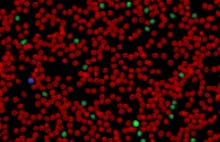Leukemia
Definition, Causes, Symptoms and DiagnosisWhat is leukemia ?
An estimated 474,519 cases of leukemia globally were documented in 2020.[1] Leukemia is a type of cancer that affects certain kinds of blood cells in their early form. Depending on the type of leukemia, the cancer may attack different kinds of blood cells with various effects, treatment options, and age groups affected.
Leukemia does not just affect blood cells. It also destroys blood-forming tissues like the bone marrow and lymphatic system. If untreated, leukemia can spread to the central nervous system and organs like the liver, spleen, lungs, and heart.
Some types of leukemia are acute, meaning that the cancer is growing at a fast rate. Others are chronic, meaning that the cancer is growing at a slower pace.
Leukemia treatments vary based on the:
- Progression and severity of the disease
- Age of the individual
- Overall health of the individual
Most often, leukemia presents in the white blood cells, which primarily fight infection. When leukemia causes abnormalities in white blood cells, it can impact the immune system, resulting in a significantly increased risk of infection.
What causes leukemia?
There is no known cause of leukemia, but researchers in the medical community have identified some common risk factors.
The development of leukemia is often attributed to various risk factors, including:
- A genetic predisposition
- Down syndrome
- Human T-lymphotropic virus (HTLV)
- Human immunodeficiency virus (HIV)
Additional risk factors are associated with environmental and lifestyle-related exposure, such as[2]:
- Exposure to petrochemicals (i.e., benzene)
- Prolonged exposure to artificial ionizing radiation
- Some alkylating chemotherapy agents
- Tobacco use
- Certain hair dyes
What are the symptoms of leukemia?
While different variations of leukemia present various symptoms, there are some similarities across most of the common leukemia types.
- The most common leukemia symptoms include[3]
- Fatigue
- Muscle weakness
- Pallor
- Recurring fever or chills
- Frequent infection
- Unexplained weight loss
- Enlarged lymph nodes, liver, or spleen
- Recurring nosebleeds and easy bleeding or bruising
- Bone pain
- Excessive sweating
- Petechiae (tiny red, flat spots on the skin)
How is leukemia diagnosed?
If any of the above symptoms are present, you should see a doctor right away.
Your doctor will likely first give you a physical examination. Next, your doctor may recommend testing for unrelated issues to rule out other causes. If several symptoms are present, especially over a prolonged time, your doctor may then order blood work to test for leukemia.
Blood tests and bone marrow tests are the only way to confirm whether leukemia is present in the body. If blood samples show abnormal results — for example, a high white blood cell count — this may indicate leukemia.
A bone marrow test involves removing a small sample of bone marrow, typically from the hip. A laboratory technician will test the blood and bone marrow samples for the presence of leukemia cells, which would help the doctor confirm their diagnosis.
What are the different types of leukemia?
According to the American Cancer Society, there are six commonly identified types of leukemia.[4]
Of these, there are both acute (faster-growing) leukemias and chronic (slower-growing) leukemias.
- Acute lymphocytic or lymphoblastic leukemia (ALL) originates in the bone marrow. It’s more common in children under five than in adults.
- Acute myeloid leukemia, often called acute myelocytic leukemia, acute myelogenous leukemia, acute granulocytic leukemia, or acute non-lymphocytic leukemia (AML) also starts in the bone marrow but quickly moves into the blood and/or lymph system. It’s most common in older adults.
- Chronic lymphocytic leukemia (CLL) is common and accounts for about one-third of all leukemia cases. This type begins in white blood cells called lymphocytes.
- Chronic myeloid leukemia or chronic myelogenous leukemia (CML) originates in the blood-forming cells of the bone marrow, eventually spreading to the blood. This type accounts for roughly 15% of leukemias in adults.
- Chronic myelomonocytic leukemia (CMML) is yet another type of leukemia beginning in the blood-forming cells of the bone marrow before invading the blood. It primarily affects older adults.
- Children’s leukemia is most often either acute lymphocytic leukemia (ALL) or acute myeloid leukemia (AML). Leukemia is the most common type of cancer in children and teens and is almost always acute rather than chronic.
What is acute myeloid leukemia?
Acute Myeloid Leukemia (AML) is among the most common types of leukemia found in adults. It’s usually not found in patients under age 45, although some AML cases are diagnosed in children.[4:1]
Usually, Acute Myeloid Leukemia develops when cells that should turn into white blood cells grow abnormally into cancerous cells. AML doesn’t affect cells known as lymphocytes but affects myeloid cells responsible for protective immunity and tissue repair.
While AML begins in the bone marrow, it can quickly spread into the blood, lymph nodes, liver, spleen, testicles, brain, or spinal cord. AML is a serious type of leukemia cancer but can be treatable.
What is feline leukemia?
Feline leukemia virus (FeLV) occurs in cats and is quite common, affecting between 2 and 3% of all cats in the United States.[5]
Feline leukemia can cause many of the same symptoms in cats as are found in human leukemia patients, including:
- Fatigue
- Weight loss
- Swollen lymph nodes
- Fever
- Loss of appetite
The disease is contagious among cats and often passed through saliva, blood, urine, and feces but cannot be transmitted to humans or other animals.
Can you prevent leukemia?
There is no isolated way to prevent leukemia. Many of the risk factors are genetic, but since there is some risk associated with tobacco, chemicals, and radiation, there are a few lifestyle choices you can make to decrease your chances of developing this type of cancer.
Here are some things you can do to prevent leukemia:
- Avoid smoking tobacco
- Prevent or reduce your exposure to industrial chemicals and pesticides
- Avoid unnecessary medical radiation like computed tomography (CT) scans, fluoroscopy, and nuclear medicine imaging exams unless medically necessary.
Discover Sight's Automated CBC Analyzer
Sources
- Sung H, Ferlay J, Siegel RL, et al. Global Cancer Statistics 2020: GLOBOCAN Estimates of Incidence and Mortality Worldwide for 36 Cancers in 185 Countries. American Cancer Society Journals. https://acsjournals.onlinelibrary.wiley.com/doi/10.3322/caac.21660. Published ↩︎
- What Causes Leukemia. Moffitt Cancer Center. https://moffitt.org/cancers/leukemia/diagnosis/causes/. Accessed July 20, 2021. ↩︎
- Leukemia. Mayo Clinic. https://www.mayoclinic.org/diseases-conditions/leukemia/symptoms-causes/syc-20374373. Published January 13, 2021. Accessed July 20, 2021. ↩︎
- Leukemia. American Cancer Society. https://www.cancer.org/cancer/leukemia.html. Accessed July 20, 2021. ↩︎
- Feline Leukemia Virus. Cornell University College of Veterinary Medicine. https://www.vet.cornell.edu/departments-centers-and-institutes/cornell-feline-health-center/health-information/feline-health-topics/feline-leukemia-virus. Published April 29, 2021. Accessed July 20, 2021. ↩︎
Disclaimer: The content of this knowledge post intends to provide general information related to topics that are relevant to blood diagnostics and may not be used in relation to the operation of Sight OLO. For detailed information on the diagnostic parameters and specifications of Sight OLO, please refer to the official Operator's Manual.

